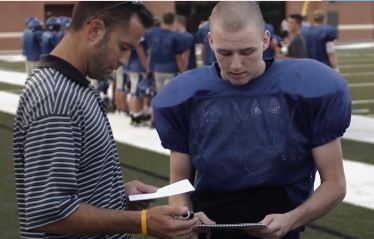One of the things I try to do every day is carve out time to keep up with what people are saying on Twitter, and occasionally throwing in my two-cents worth. For those of you reading this blog who follow MomsTEAM on Twitter, it won't come as any big surprise that concussions in sports seems to be the topic that most often lights up the youth sports Twittersphere.
But as anyone active on Twitter also knows, condensing one's thoughts into 140 character "tweets" is often a challenge, and can sometimes leave a lot to be desired, especially when one is talking about a subject as complex as concussions.
Last night was one of those times.
I was following a conversation about benching kids in case of suspected concussion and the use of sideline assessment tools in making "remove from play" decisions, and decided to offer my thoughts.
The use of screening tools on the sports sideline in case of suspected concussion is a subject with which, with all due modesty, I have more than a passing familiarity, not just from writing blogs and articles on the subject and from reading all of excellent articles written by MomsTEAM's Team of Experts, but also from my first-hand experience in producing "The Smartest Team: Making High School Football Safer (PBS)" MomsTEAM's soon-to-be-released documentary about the implementation by one Oklahoma high school football program - with our help - of a concussion risk management program.
One of the most important elements of such a program we highlight in the documentary is to make sure, in case a concussion is suspected, that the team doctor and/or certified athletic trainer conducts an immediate assessment on the sideline utilizing one or more available sideline screening tools (e.g. Standardized Assessment of Concussion, SCAT2, Balance Error Scoring System a/k/a BESS and King-Devick) and, based on such assessment, to either allow an athlete to return to play or hold the athlete out for the remainder of the game (as is now required by law in more than 40 states) and referred for further evaluation. The default rule, of course, is to follow the by now familiar mantra, "When in doubt, sit them out."
Last night, one of MomsTEAM's favorite Twitter followers, Andrew M. Blecher, M.D., the Medical Director of the Center for Rehabilitation Medicine and occasional guest blogger for MomsTEAM who goes by the handle, jocdoc, tweeted the following:
If concussion is suspected enough to give test then sit them out & send for eval.
I responded with the following post:
Some ATs and coaches are going overboard and the sideline tests help validate if kid is ok.
Some viewed my post as suggesting that athletic trainers and coaches were being too conservative by sitting out kids suspected of concussion, but that is not what I said, and certainly not what I meant to say in the slightest.
Lost in the post was the admittedly nuanced point I was trying to make: that athletic trainers and coaches who kept kids from returning to play simply because they saw a kid take a hard hit, or because a sensor went off alerting them to a blow that might cause concussion, without performing any sideline assessment, might be viewed as going overboard.
There are lots of times players take very hard hits and get right up and run back to the huddle. For any of number of reasons, as I wrote in my last blog post, the mere fact that the player got up and kept playing doesn't mean, of course, that they haven't sustained a concussion.
I am all in favor of a coach or AT pulling a player out of the game, based solely on the blow they witnessed or that triggered an alert on their iPad. But here is where it gets tricky: If they simply sit the player down for the rest of the game without doing any sideline assessment, I think that is going overboard.
Here's an example of what I am talking about. During one of the pre-season practices I attended last August during the filming of "The Smartest Team," one of the players sustained a hit which, from my untrained eye, appeared to be one that could have caused a concussion. Even though the athlete got right up, the athletic trainer had him come off the field so he could administer both the King-Devick (see screen grab from the movie at right) and BESS tests. When he passed both tests, he was allowed to return to practice.

What if the athletic trainer had decided, based solely on the magnitude of the hit, to hold the player out without using any of the assessment tools he had in his concussion toolbox? Could he have been accused of "going overboard"? I respectfully suggest that he might.
Again, I am not saying the opposite: that players should be allowed to return to play willy-nilly, without an evaluation, or that, when a sideline assessment is inconclusive, the athletic trainer shouldn't, in the exercise of caution, hold the player out.
All I am saying is that there has to be some basis for holding the player out beyond the fact that he took a big hit. After all, every player's brain is different. Where he was hit (the top of the helmet, the side of the helmet etc.), whether the hit was direct (to the head) or indirect (a hit to the body with forces transmitted to the head), the direction and magnitude of both the linear and rotational forces involved, and a variety of other factors, both known and yet to be identified (such as the player's concussion history, possible genetic pre-disposition, and/or pre-existing neurological conditions, such as a history of migraines or ADD/ADHD), all affect how a player responds to concussive and sub-concussive blows. Concussion management is not one-size-fits-all. Concussion identification shouldn't be either.
The bottom line: it isn't just players on the field who need to play smart; sideline personnel need to play smart, too.










